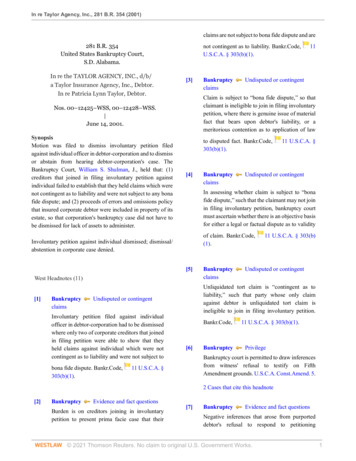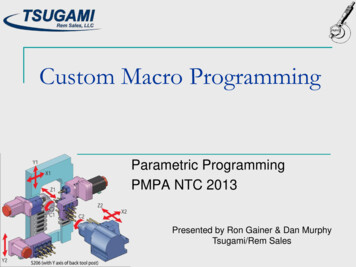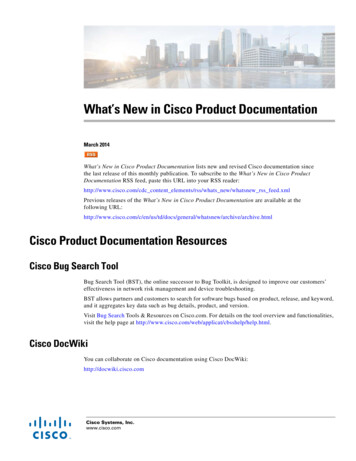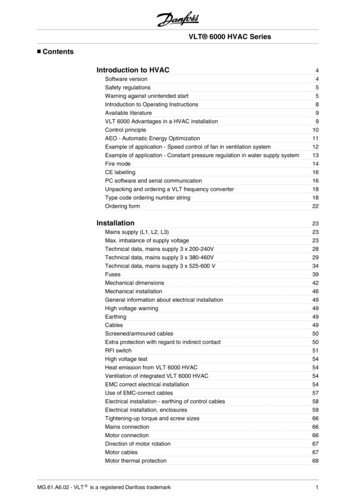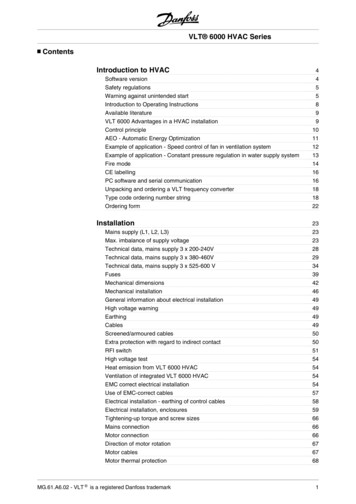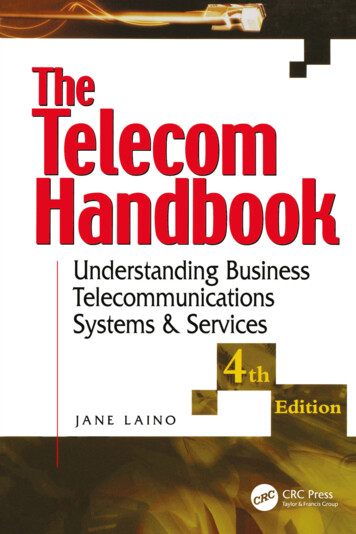
Transcription
4 T H EDITIONThe Telecom HandbookUnderstandingTelephone Systems& Servicesby JANE LAINO(cJ*CRC PressTaylor & Francis CroupBoca Raton London New YorkCRC Press is an imprint of theTaylor & Francis Group, an informa business
CRC PressTaylor & Francis Group6000 Broken Sound Parkway NW, Suite 300Boca Raton, FL 33487-2742First issued in hardback 2017 2002 Jane LainoCRC Press is an imprint of Taylor & Francis Group, an Informa businessNo claim to original U.S. Government worksISBN 13: 978-1-138-41245-3 (hbk)ISBN 13: 978-1-57820-071-9 (pbk)This book contains information obtained from authentic and highly regarded sources. Reason able efforts have been made to publish reliable data and information, but the author and publishercannot assume responsibility for the validity of all materials or the consequences of their use. Theauthors and publishers have attempted to trace the copyright holders of all material reproduced inthis publication and apologize to copyright holders if permission to publish in this form has notbeen obtained. If any copyright material has not been acknowledged please write and let us know sowe may rectify in any future reprint.Except as permitted under U.S. Copyright Law, no part of this book may be reprinted, reproduced,transmitted, or utilized in any form by any electronic, mechanical, or other means, now known orhereafter invented, including photocopying, microfilming, and recording, or in any informationstorage or retrieval system, without written permission from the publishers.Trademark Notice: Product or corporate names may be trademarks or registered trademarks, andare used only for identification and explanation without intent to infringe.Visit the Taylor & Francis Web site athttp://www.taylorandfrancis.comand the CRC Press Web site athttp://www.crcpress.comDesign by: Pattie StoneCover by: Saul Roldan
The Telecom Handbook by Jane LainoThe Telecom Handbook is being used successfully by over25,000 people who need a quick, basic understanding of the tele phone systems and services used by today's organizations. Theinformation presented is useful and easy to access. Author JaneLaino's expertise has developed from her early days working atthe telephone company to her subsequent creation of DIgby4 Group,Inc., one of New York City's fastest growing telecommunicationsconsulting businesses. Her down-to-earth approach translates con fusing terms and complex concepts into plain English.This book is an important and unique resource for: Business People who purchase and manage telephone sys tems and services. Information Technology Professionals who are handed theresponsibility for corporate telephone systems.Business Owners who want to understand their company'smost critical system.ITelecommunications Companies who need to train new staffmembers. Next Generation Telecom Developers who need to know whatpeople expect from their telephone systems. Students and Educators who will supply the workforce withneeded telephony expertise in the 21 ST Century.I Investors in Telecommunications Companies who want tounderstand the industry and terminology. Bookstore Owners and Managers who offer rows of com puter books for sale, but few basic books on telephone systemsand services.A quick look through the Table of Contents and Index willpreview what's in the book so you can see if it's right for you.For tips on managing telephone systems, services and expensesvisit DIgby 4 Group, Inc.'s web site at www.digby4.com.The Telecom Handbookiii
This book is dedicated to my parents,Fern and Bill Coe.
THE TELECOM HANDBOOKTable of ContentsPARTITelecommunications Systems1Chapter 1 - The Telephone3Parts Of The Telephone5Telephone Functions Depend Upon the System11Older Style Telephones Still in Use12Labels12Color Trivia13Expanding the Number of Buttons13Ringing14How Does The Telephone Work?14Digital vs. Analog Telephones19The Continued Importanceof the Telephone on Your Desk20Chapter 2 - Your Business Telephone System - The PBX . . 2 1What is a PBX?21Understanding Your Own System22What is the Physical Makeup of the PBX?22A Look Inside The PBX Cabinet24PBX Shelf24PBX Circuit Boards25Other Components Inside The PBX Cabinet28PBX Sizing and Growth29How the PBX Works31Earlier PBXs and How they Worked33The Telecom Handbookvii
THE TELECOM HANDBOOKTelephone System Design(PBX and Key Systems)34PBX Functions (Also Called Features)41System Features Accessible To The DesktopTelephone Working With A PBX42Expense Control Function of the PBXs49Typical Differences Between Key Systemsand PBXs55Wireless Telephones with a PBX55PBX Disaster Recovery Planning55Chapter 3 - Purchasing a PBX59Identifying Your Organization's Requirements59Top 10 ( 1) Places To Go Wrong When Planning For AndPurchasing A New PBX59Identifying the Requirements62A PBX Request For Proposal (with sample questions)64Chapter 4 - Your Call Center Telephone System The ACD75ACD Hardware76ACD System Features77Performance Measurement80Agent Capabilities81Supervisor Capabilities84Caller Support Capabilities87Network Services (Outside Lines) for ACDs88Other Call Center Capabilities89Perspective91The Call Center Approach to DesigningOffice Telephone Systems93Chapter 5 - Voice Mail and Automated AttendantDefinition by How it Sounds to the Callerviii The Telecom Handbook9595
THE TELECOM HANDBOOKPhysical Components of Voice Mailand Automated Attendant96Different Ways of Setting it Up97Automated Attendant99Voice Mail System Components100Voice Mail Capabilities for the Caller102Voice Mail System Capabilities for theMailbox Owner103Other Voice Mail Features104Voice Mail Administration104Voice Mail System Implementation and Integrationwith the PBXNetworking Voice Mail AmongMultiple Locations106108Voice Mail Service Bureaus109Voice Mail Purchasing Questions110Unified MessagingIllChapter 6 - Call Accounting andTelemanagement Systems115Call AccountingTelemanagement Systems115126PART IITelecommunications Convergence137Chapter 7 - Convergence of Voice and Data139Perspective139Introduction140An Earlier View of Convergence141Product Categories Enabling Convergence142Engineering-Based Convergence Concepts143Putting The Pieces Together152The Telecom Handbookix
IME TELECOM HANDBOOKWhere The Network Components Are LocatedCommunications Servers ReplacingThe "Mainframe" Switch153The Concept Of Specialized Networks158Applications-Based Convergence Concepts159Computer Telephony Applications Development161Other Computer Telephony Applications166Chapter 8 - Interactive Voice Response Systems154171How The IVR Provides Information172IVR Management Information Available177IVR Implementation178Chapter 9 - Fax Servers181What is a Fax Server?181Fax Mail182Fax-on-Demand184Methods of Document Selection189Broadcast Fax193Fax Library Management195Methods of Creating and Importing Documents197Fax-on-Demand and Fax Broadcast Applications198Fax-on-Demand Cost Justifications199Configuring Fax-on-Demand201PART IIITelecommunications Transmission andOutside LinesChapter 10 - Outside Lines205207Circuits To Connect Your Telephone System (PBX or KeySystem) To The Local And Long Distance Companies . . . 207T-l Circuit Applications for PBXsx » The Telecom Handbook219
THE TELECOM HANDBOOKOther Types of Telecommunications Circuits(not typically connected to the PBX)Chapter 11 - Transmission224235Transmission Medium235Synchronous and Asynchronous Transmission236Modems237Multiplexers241CSU/DSU Hardware243More Transmission Hardware243Bandwidth244Simplex vs. Duplex244Protocols245Analog vs. Digital2452-Wire vs. 4-Wire246Chapter 12 - Cable247Unshielded Twisted Pair Copper Cable247The Concept of Speed or Bandwidth248UTP Configurations248Jacks249Power at the Desk251Main and Intermediate Distribution Frames252Shielded Twisted Pair254Screened Twisted Pair Cable255Grounding255Advantages and Disadvantages ofTwisted Pair Copper Cabling255Coaxial Cable256Fiber Optic Cable258Purchasing Cabling and its Installation260Building Cabling Systems261Cabling Standards264The Telecom Handbookxi
THE TELECOM HANDBOOKPART IVTelecommunications IndustryChapter 13 - Understanding theTelecommunications Industry273Telecommunications Network Services(Outside Lines And Calls)274Telecommunications Systems (Equipment)283Software And Service Companies293Professional Services295Outsourcing Resources - Who To Call297Chapter 14 - Historical Perspective onThe United States Telecommunications IndustryTelecommunications Industry History:A Personal Perspective From The AuthorINDEXxii271The Telecom Handbook299304311
Thanks For Your Help EveryoneTo Harry Newton - founder of Telecom Books and author ofNewton's Telecom Dictionary. Harry developed the idea forthis book in 1994. He realized the need for a basic book ontelecommunications, particularly for people in the computerindustries. The book was originally titled "Telephony forComputer Professionals." Harry continues to be an inspira tion to me and to many others in our industry.To Frank Brogan and Matt Kelsey of CMP for their encourage ment and patience.To John Jainschigg, editor of Communications Convergencemagazine, for sharing his insights on the future for the chap ter on Convergence of Voice and Data.To Christine Kern for her support and her cheerful countenance.It's been a pleasure to work with her.To Steve Teta for his patient review of the book from a technicalperspective.To Gioia Ambrette and the staff of Newcastle Communicationsin New York City for their help with the chapters on VoiceMail, Interactive Voice Response, Fax Server and Call Ac counting. Their company specializes in selling and settingup these applications.To Eric Burger of Snowshore and the International SoftswitchConsortium. Eric's help with the chapter on Convergence ofVoice and Data was invaluable.To Gordon Fowler and Anthony Abbott for their review andsuggestions for the chapter on Convergence of Voice and Data.To Don Stigliano and John Walston of Netversant for their timeand help on the PBX Chapter.rcontinued.The Telecom Handbook * xiii
THE TELECOM HANDBOOKTo Al Festa and Dan Krych of C&C Sales for their help with thechapter on Cable.To Dave Crozier for his help with the chapter on Cable and hiscreative suggestions.To Cahal Grennan of Pingtone for his contribution to the chap ter on Convergence of Voice and Data.To Fran Blackburn for her contribution to the chapter on Auto matic Call Distributors. Intecom makes ACDs for Call Centers.To Pattie Stone for her meticulous desktop publishing and graphicdesign services and creative suggestions. Pattie's support hasbeen invaluable in getting this 4th edition ready.To the Staff and Associates ofDIgby 4 Group, Inc. who keepour company growing and our clients happy - including DianeVentimiglia, Jean Fitzpatrick, Laura Taylor, Olga Dawidowiczand Kathy Charlton.To the wonderful clients ofDIgby 4 Group, Inc. for their confi dence in us.To my husband, Rich Laino, for his patience and support.To all of my friends in the telecommunications industry eachwho has helped me in his own unique way.- Jane Laino, New York City, 2002xivThe Telecom Handbook
THE TELECOM HANDBOOKAbout the AuthorJane Laino is president of DIgby 4 Group,Inc., a telecommunications consulting com pany providing services to a growing base ofbusiness clients.DIgby 4 helps organizations to manage telecommunications tech nology. DIgby 4 clients are comfortable that their systems andservices are being purchased at the right price and are appropri ate for how they plan to use them. For more information on DIgby4 Group, Inc. go to www.digby4.com.Jane's history in the telecommunications industry includes sevenyears with the Bell System, New York Telephone and Southwest ern Bell (now called Verizon and SBC) and four years withNatCom, Inc. In 1979 she founded DIgby 4 Group, Inc.She is known for having a practical, hands-on approach to con sulting. This translates to the style from which the clients of DIgby4 Group, Inc. benefit.She is a member of the Society of Telecommunications Consult ants. Her speaking, teaching, writing and consulting engagementskeep DIgby 4 Group up to date and actively learning in the fastmoving telecommunications industry.Jane lives in New York City during the week and in Southampton,NY on the weekends. She is married to Richard Laino. She wasborn in Jersey City, NJ and grew up in Bayville, Long Island,NY. She is a graduate of Queens College of the City of New Yorkwith a B.A.degree.In addition to this book, she is author of The Telecom Tutorials,now in its 2 ND edition.The Telecom Handbookxv
THE TELECOM HANDBOOKForeword(original foreword circa 1994)Why I Asked Jane Laino to Write This Bookby Harry NewtonMany computer people are in for a nasty shock. They thinkbecause the technologies of computing and telecommunicationsare similar and the two are "merging," they'll feel right at home.They are wrong. Dead wrong. The phone business is completelydifferent from the computer business. In every possible way.How different they are is reflected in the fact that not onesingle computer company I can think of has made money in tele communications. IBM lost over 2 billion. It bought Rolm, thePBX switch maker. It started Satellite Business Systems, the longdistance phone company. And, at one stage, IBM even manufac tured and sold its own PBXs in Europe. All these ventures aregone; closed or sold at a whopping loss. Ditto for Honeywell,which at one stage, owned a collection of interconnect compa nies - PBX telephone sales, installation and service companies.The telephone industry has fared no better. AT&T lost so muchin its own computer business (it sold its own Unix machines andprivate-labeled Olivetti MS-DOS PCs) that is was forced to buyNCR to cover its immense computer losses.The local phone companies have fared even worse. WhenAT&T's Bell system was broken up in 1984 into AT&T and seven"Baby" Bells, the Judge made each of the Baby Bells "holding"companies, called RBOCs (for Regional Bell Operating Compa nies). This meant presumably, that they were meant to "hold"something. Like AT&T, they thought there was big money in thecomputer industry - presumably on the philosophy that thingsunknown are more intriguing that things we know about. Thus,in order to "hold" something, they bought everything in softwareThe Telecom Handbook * xvii
THE TELECOM HANDBOOKand computer retailing they could get their hands on. Nynex evenbought IBM's computer retail stores - the ones IBM couldn'tmake money on. At one stage, Nynex even tried to compete withIBM's money-losing Prodigy service. Nynex's venture lost oodles,also. Virtually every other RBOC got into software and lost moremoney than most of us ever dream about. One RBOC bought asoftware company for 340 million and sold it the following yearfor around 160 million. Today, all the RBOCs' computer dalli ances are gone, at millions of dollars cost to their poorshareholders, who mistakenly thought they bought shares in a"safe utility."To show how different the computing and telecom businessesare, let's look at each management discipline. Let's compare acomputer company to a local telephone operating company, Bellor independent. Apologies in advance if this seems trivial. It'snot. I don't have the space; but if you want to pursue this fasci nating subject, e-mail me on HarryNewton@MCIMail.com. 1 Differences between a "computer" companyand a local telephone company: Sales. The computer industry is obsessed with selling. Everysenior executive in any successful computer company is agreat salesman. In contrast, telephone company executivesare lousy salesmen. They've never had to be good - all theircustomers are captive. If you have a business in New YorkCity, who else can you get dial tone from? What choice doyou have?The telephone company actually has one "customer." It'scalled the Public Service Commission, the local state regula tory agency. That agency determines how much or how littlemoney the phone company makes. The problem is that thelocal phone company doesn't see the agency as a "customer."It sees the agency as an adversary, an enemy who is alwaystrying to reduce the telephone company's efforts and legiti mate rewards. So the "sales" approach is always wrong. It'sxviiiThe Telecom Handbook
THE TELECOM HANDBOOKalways, "Let me earn more money. Gimme. Gimme. Gimme."It should be, "I'll do this for you and the fine people of thisState if you let me earn more money." The nice people whowork at the PSC, who earn far less money than the telephonecompany executives who visit them, naturally resent this high handed "Gimme. Gimme. Gimme." approach. And theytypically do everything within their meager power to messup the telephone executives' placid and pleasant lives.Innovation. Computer companies only sell stuff if theysell new stuff. To live they must innovate. Phone companiesdo not innovate. They have essentially been selling the sameservice - 3 kilohertz switched phone service - for 120 years.There are a handful of new digital services which businesses,if you're lucky to be located in the right place at the righttime, can get - T-l, digital Centrex, etc. But the list is miser ably small. With only a handful of exceptions, the phoneindustry's new product marketing efforts have failed. Eventouch-tone service, introduced into North America in 1963(over 30 years ago), still has less than 70% penetration.In other words, over 30% of Americans have found touchtone so unappealing they don't have it. The irony is that havingits customers on touch-tone actually benefits the phone com panies enormously because it lets them buy cheaper switchingequipment and run their equipment fast and more economi cally. (They should be giving touch-tone away for free).Engineering. There is innovation in the phone industry. It'sjust that it's internally focused. The phone industry has beenquick to buy modern equipment which works better, morereliably, saves labor, etc. Testimony to this is that phone con versations today sound a lot better than they did ten yearsago. And phone systems break a lot less often. As a result,the phone industry (AT&T, the Baby Bells and GTE) havefired over 250,000 people since divestiture, bringing downtheir costs. You and I, as customers, haven't seen those costThe Telecom Handbook « xix
THE TELECOM HANDBOOKsavings in our bills (with the single exception of long dis tance phone bills). Think of the cost/speed/performanceimprovement in your PC over the past ten years; think of thecost/speed/performance in your telephone bills over the sameten years. You should have had a commensurate improve ment in telephone services. The two technologies are the same.Yet the industries are very different. What happened to allthose freed-up monies in the phone industry? Try high sala ries, waste, large expense accounts and all the millions lostin failed computer ventures.Executive motivation. If you perform in the computer in dustry you do well. Your career prospers. Bill Gates says heonly wants to hire people who've made serious mistakes. Hewon't hire anyone from the phone industry. No one in thephone industry makes decisions that fail. They just don't makedecisions. The rule in the phone industry is simple: You'llnever be penalized for not making a decision. So the ten dency is never to make a decision. Go to meetings.Commission studies. Go to more meetings. Commission morestudies. Don't ever do anything.Here's a true story,.New York Telephone employed me as a marketingconsultant. I went to the first meeting. I asked,"Who's your largest prospect?" It was a customerwho could give New York Telephone (now calledNynex) about 115 million a year in revenues andabout 15 million to 20 million in profits a year. Iasked, "Who's the salesman on the account?" Turnsout that New York Telephone didn't have a sales man dedicated full-time to the account, and worse,the customer hadn't been visited in over fourmonths. I suggested that they appoint someone. Thisrecommendation took rocket science intellect on mypart. Everyone on the third level managementxx * The Telecom Handbook
THE TELECOM HANDBOOKagreed. The vice president (fifth level) agreed thiswas a good idea. But the assistant vice president(fourth level) said that he wanted "to think about it"and have a meeting or two. I gave him till 5 PM thefollowing day. At 5:05 PM, I walked into his officeand asked what his decision was? He said he neededmore time to think. I said there was no more time. Iwent upstairs to the vice president, who had alreadywarned me that his 140,000 a year AVP was "use less." I told the VP that his AVP was being stupidand I recommended that he fire him on the spot. TheVP answered, "You're 100% right. The man is stu pid. He should be fired. But we can't do that aroundhere." I immediately handed in my resignation. Acouple of years later, I met the AVP. He had beengiven a promotion, a higher salary and moved toNynex! I have no idea if they ever sold the account.Customer relations. Computer companies want to pleasetheir customers. Telephone companies want to keep their cus tomers from complaining. The BIG thing that gets a telephoneexecutive's attention is a complaint letter to the local PSC,or a complaint letter to the president of the telephone com pany. Computer companies want the excitement of new sales.Telephone companies want the peace of non-complaining cus tomers who unquestioningly pay their monthly phone bills.Education. Go to any bookstore. You'll find acres of bookson computers. Try to find the books on telephones. This is notaccidental. The telephone industry figured long ago that if itcould keep its customers in the dark with a "Trust me, Trustme," philosophy, they could sell them and charge whateverthey wanted. You don't believe me? Find your company'slast month's phone bill. Ask yourself what all the line itemsmean? Ask yourself, "Are you really using what you're pay ing for?" Now, call your local phone company's businessoffice and ask them to explain what's on the bill. Good luck.The Telecom Handbook * xxi
tWE TELECOM HANDBOOKIt's not because telephone services are complex. Computersare much more complex. It's because the telephone industrydeliberately chooses to obfuscate how it bills for its productsand services.Common MistakesThat's enough of the differences. Let's list a few of the morecommon mistakes computer companies make when dealingwith phone companies: Motivation. "If I do this," the computer company says, "yourphone company will get X thousand more per month. Solet's do this joint deal together." Says the phone company,"Seems like a good idea to me. Let me study it." Translation:"When we've studied it to death in our various million com mittees, we might do a field trial. But the trial will be set upin such a way that it will fail. And then I won't ever have tomake a decision to go ahead or not go ahead."You, as an outsider, cannot assume that phone compa nies are motivated to increase their sales and their earnings.Remember, their earnings are limited by the local PSC.Whatever you do for them - and I stress whatever you dofor them - you can never do what the local PSC can domuch less painlessly and with much greater effect; i.e., getthem money. Moreover, no phone company executive hasany significant number of shares in his own company. Evenat the highest level.Virtually anyone that has ever relied on the phone com pany to do anything in a speedy, intelligent manner has gonebroke waiting. I can present you with lists of companies. Theacute lack of motivation translates into deliberate glacialspeed, which will kill any outsider's motivation. Speed. The phone company works at its pace, not yours. Youmay build yourself a palatial 100 million office complex.xxii « The Telecom Handbook
THE TELECOM HANDBOOKYou want to be in on January 1. All your contractors may beon some form of motivation, bound by a written contract.Except one. The phone company. Your "written contract" withthe phone company is the tariff which the phone companyhas filed at the PSC. That tariff typically states that if they'relate installing their lines, tough. You wait. You can scream.And screaming often works. But it's very exhausting. In fact,dealing with the phone industry is always exhausting. In short,don't believe any promises they make about delivery. Ever.Homegrown. The phone industry never hires from outsideits own industry. That's not 100% true. They have been hir ing some low level, not-too-bright executives. But you won'tfind any senior executives. Even IBM went outside for itsnew boss. You won't find that happening in the phone indus try. The executives are very protective of their own secure,overpaid positions - after all, you, the customer, can still makea phone call, etc. So why should you complain? You some times sit in meetings with these people, as I have done, andwonder which planet they just stepped off.I think it's getting worse. To "fire" those 250,000 people,they offered many of them retirement and departure finan cial incentives that you'd have to be just plain stupid not toaccept. You could argue, as a result, that the average IQ ofthe country's telephone company executives has dropped. Youwouldn't be wrong. It's sad.Is Any of This Going to Change?The good news is that it will. It won't change because com panies like Nynex change. They won't. They'll still be glacial,visionless, unmotivated and difficult to deal with. But they'll getcompetition. Technology is the great change merchant. It alwayshas been in telecommunications. And it always will be. Technol ogy brought MCI, Sprint and hundreds of others into longdistance. That industry improved. Ditto for telephone equipmentThe Telecom Handbook * xxiii
THE TELECOM HANDBOOKyou put in your office. Ditto for fax machines, etc. Technologywill bring competition to the local business. You'll buy local ser vice from MCI, and dozens of others. They'll want your businessand they'll do reasonable and wonderful things to get it. They'llcooperate with you in your computer telephony projects. They'llset up intelligent developer programs. They'll let you experiment.They'll let you put your equipment in their offices. They'll eventake care of your equipment. Some of this might rub off ontosome of the nation's phone companies. Bell Atlantic andBellSouth are acting more progressive. There is hope, yet. Justdon't pin your business plan on it.Harry NewtonNew York City, June, 1994xxivThe Telecom Handbook
PART ITelecommunications SystemsThe Telecom Handbook1
CHAPTER 1The TelephoneNewton s Telecom Dictionary defines the telephone as a trulyremarkable invention that does the following things:gi When you lift the receiver, it signals the local system thatyou wish to use the worldwide phone system.It indicates that the phone system is ready for you to dial bygiving you a dial tone. It sends the number of the telephone to be called. It indicates the progress of your call through tones: ringing,busy, etc. It rings to alert you to an incoming call. It transforms your speech into electrical signals for transmis sion to a distant point and translates the electrical signals itreceives back into the human voice for you to hear. It automatically adjusts for changes in the power supplied to it. When you hang up, it signals the telephone system that youare finished.The telephone is also referred to as a telephone instrument,station or set. There are single-line telephones and multi-line tele phones (also called multi-button telephones). These telephonescan be analog or digital and you cannot always tell which is whichby appearance. Telephones work with outside telephone lines fromthe local telephone company or as extensions from a businesstelephone system (PBX or Key System).The telephone is designed to operate under a wide range ofelectrical, mechanical and acoustical conditions. Some of the de sign parameters are dictated by human factors such as sound levelsof the human voice and handset dimensions (the handset is alsoThe Telecom Handbook * 3
1 Ì E TELEPHONEcalled the telephone receiver). Some parameters are historicalcarryovers such as ringing voltage and frequency. Others, suchas the minimum line current for satisfactory carbon transmitterand relay operation, are dictated by the physical properties of thematerials used in the telephone.Telephones in use today are of different vintages. The morerecently manufactured telephones substitute microphones forsome of the materials such as carbon transmitters still found inmany older telephones in use.The following pictures show a single-line telephone (Figure1.1) and a multi-line telephone (Figure 1.2). As you can see, theyvary somewhat in appearance, but have some things in common.Figure 1.1You speak intothe TransmitterTraditional Single Line Telephone(Also called 2500 Set)You listen throughthe ReceiverFigure 1.2 - Multi Line Telephone M (H M Ifl [] f H [] H [] 1Ffl B [] B [] The Telecom Handbook] 1BÜ0B1 000B BBBB1(XIIID i l lrl4] ] [H J ] H [I Bi [11
C H APT E R i l l I Parts Of The TelephoneFirst, we will point out the things you can see, and next wewill get to what is inside. Here is a diagram of a typical tele phone with its external parts labeled.Figure 1.3Parts of the TelephoneMOUNTINGCORD(Connectsto Wall)SWITCH HOOK(Under the Handset)DISPLAYX./HANDSETSPEAKERDIAL PADHANDSET CORDa. The telephone handset, also called the receiver. In fact, itincludes both the receiver enabling you to hear and the trans mitter through which you speak. It may also have a volumecontrol or a bar that you can depress to mute either the re ceiving or transmitting capability. (Buttons on the telephonemay also control these functions.)Handsets come in different shapes and sizes and areusually made to work with a telephone from a specificmanufacturer.The Telecom Handbook5
THETELEPHONEThe handset may be directly wired (also called hardwired)to the
ern Bell (now called Verizon and SBC) and four years with NatCom, Inc. In 1979 she founded DIgby 4 Group, Inc. She is known for having a practical, hands-on approach to con sulting. This translates to the style from which the clients of DIgby 4 Group, Inc. benefit. She is a member of the Society of Telecommunications Consult ants.




